
|   |

|   |
The soul of India - Padma Jayaraj, Thrissur e-mail: padmajayaraj@gmail.com June 17, 2011 The twilight rang with the soulful strains from the sarangi; Ganesh Jogi and his wife sang in strange lingo for the audience assembled in the hall of Lalith Kala Akademi, Thrissur. As perfect music flowed, the soul and spirit of India throbbed in the echoing songs of the deserts of Rajasthan. The singing couple hails from the valley of Mount Abu where their ancestors, once upon a time roused the neighborhood by singing devotional songs. 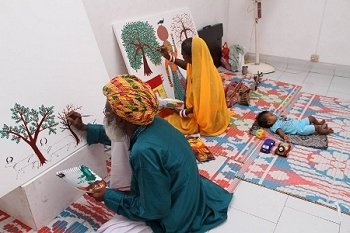 Folk artists by birth, superior artists in talent, Ganesh and his wife have set out to confront life in the raw. They sing, paint, and dance. Their wedding songs, romantic tales and devotional songs, are in folk style, the kind sung by wandering minstrels singing around a roaring fire in the cool nights of deserts. 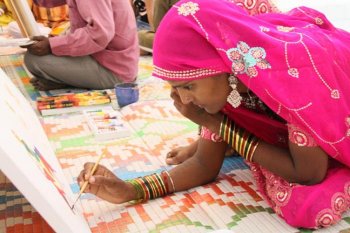
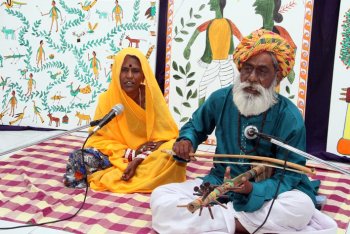
Jogi's art is both personal and representational. Singing and painting are the two sides of the same coin for him. The ability to sing is the aesthetic expression of his tribal ancestry. The themes of his paintings are the songs of his village. Of late he has moved away from the traditional to the modern as he internalizes life away from home. 
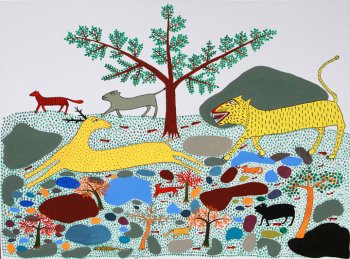
Keeping to traditions he has been painting the stories of the folk songs they sing. The Krishna tradition has its imprint with a folk touch. Jogi and his wife have painted a series of four pictures in which Krishna the flautist asks the elephant to find his lost sugar. The elephant seeks the help of the tiger. And the tiger who is about to seek the deer's help finds the entire herd escaping to safety. And finally, it is the ants in an array that bring the lost sugar back to Krishna. 
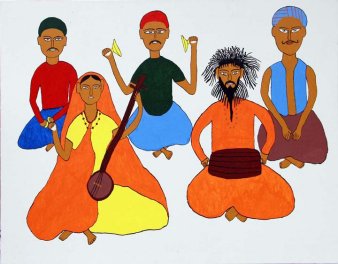
Women pining for the return of their men, is another theme. They talk to birds while feeding them. And the men materialize as if dreams come true. The rural background paints the villages of India. Trees that form the background are laden with leaves, flowers, and fruits. The technique too is singular. The painting is done directly by dipping the brush into the paint and marking dots: flashy orange among deep green is rich indeed! 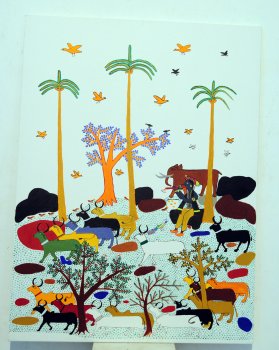 The birdscape is a delight: birds rise from the lake; wing the horizon; fill the sky. The landscape is special: grassy land dotted with barren rocks, animals leaping, and a tree in the middle as if the lord of the region. Animals dive pulsating with life. Nature is evoked in verdant green with contrasting bright hues to mark flowers and fruits. The colorful paintings have liveliness and a rustic charm that give them the folk touch. The hallmark of Jogi's painting is self portrayal which is rare in folk art. ‘There is the portrait of the family in a singing session. The woman playing on the sarangi is accompanied by men on the drum and another chiming cymbal while the others sing. The male with his flashy orange turban is the artist himself that we find in many of his paintings. He is seated in front of his Guru in one; he is the family man in another. He is part of the cityscape. His orange turban is the insignia that paints his identity as a folk artist. He is conspicuous in the crowd in the street. There is a railway series that shows a train in the platform where we find the artist jostling in the crowd. Yes, he is always on the move with his wife. His sons and their families accompany him at times, singing and painting, to different parts of his land. On their travels, they come across admirers, art lovers, promoters and patrons. Ganesh Jogi's art has been recognized for its merit. His song, "Dheko sakhi…" in the film Mirch Masala has given him fame. He went to Japan to take part in the Festival of India. They have exhibited their work in Delhi and have sung for the All India Radio, Rajkot. As he paints for the archival collection of Lalithkala Akademi, he proudly shows the copy of a book of his earlier paintings documented in German by an admirer who visited India. Four people are engaged in painting, Ganesh Jogi and his wife, their son and his wife while three kids are asleep on the mat. The grandchildren of Ganesh Jogi eat and play around them as they work. Surely the gene passed on is nurtured in this unconventional studio true to the traditions in Bharath where passionate artists have wandered in search of work from time immemorial. These children are to carry on the line of continuity which will surely brighten the horizon of Indian art one day. Their paintings have reached Europe, America, Japan and Sweden. Yet, owing to the socio-political twists and turns of the urban area near Ahmedabad, they work as forced laborers for a living: the tragedy of genius in our troubled times. The haunting melody reverberated in the hearts of the people assembled, the soul and spirit of India, echoing in our subconscious. "My soul is like an eternal garden If you meet Lord Ram, Convey to him my respects And say, if he be my guest I will offer boiled rice, sugar and milk, And nectar water with my palms And myself I will offer at his feet" Padma Jayaraj is a freelance writer and a regular contributor to www.narthaki.com |